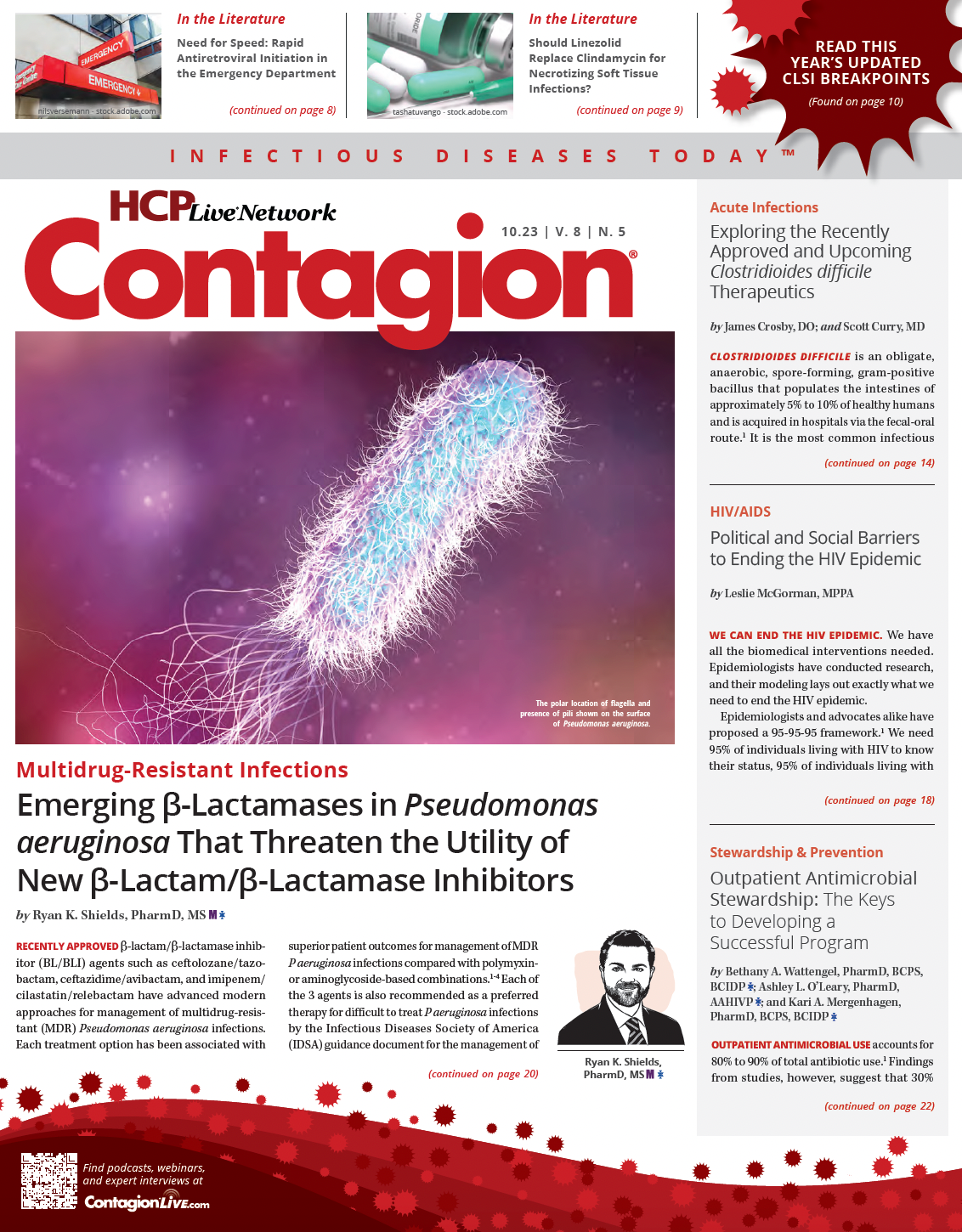Recently approved β-lactam/β-lactamase inhibitor (BL/BLI) agents such as ceftolozane/tazobactam, ceftazidime/avibactam, and imipenem/ cilastatin/relebactam have advanced modern approaches for management of multidrug-resistant (MDR) Pseudomonas aeruginosa infections. Each treatment option has been associated with superior patient outcomes for management of MDR P aeruginosa infections compared with polymyxin-or aminoglycoside-based combinations.1-4
Each of the 3 agents is also recommended as a preferred therapy for difficult to treat P aeruginosa infections by the Infectious Diseases Society of America (IDSA) guidance document for the management of antimicrobial-resistant gram-negative infections.5 Not surprisingly, the development of resistance following treatment with each of the 3 agents has been reported.6-8 Baseline resistance against P aeruginosa, however, can vary within individual institutions and across geographic regions. A key determinant mediating this differential activity is the presence of β-lactamases. For ceftolozane/ tazobactam, the addition of tazobactam does not significantly expand the in vitro activity of ceftolozane. Accordingly, ceftolozane/tazobactam demonstrates only marginal activity in regions where extended-spectrum β-lactamase (ESBL) or carbapenemase enzymes are common in P aeruginosa.9 On the other hand, avibactam and relebactam expand the activity of ceftazidime and imipenem, respectively, against β-lactamase– producing P aeruginosa.
Both agents inhibit serine class A Klebsiella pneumoniae carbapenemase (KPC) enzymes but not class B metallo-β-lactamases (MBLs). In the United States, carbapenemase-producing P aeruginosa is rare, and all 3 BL/ BLI agents demonstrate reliable in vitro activity against MDR P aeruginosa.10 The same is not true in South America and Eastern Europe, however, where carbapenemase-producing P aeruginosa is more common.9,11
Fortunately, both KPC- and MBL-producing P aeruginosa can be detected by commercially available nucleic acid–based assays that offer clinicians vital information when devising treatment strategies for patients. A more complicated and growing problem is the presence of β-lactamase enzymes that mediate variable activity for the preferred BL/BLI agents that are not detected by molecular tests. Such enzymes emerging internationally include class A β-lactamases such as Guiana extended spectrum (GES), Pseudomonas extended resistant (PER), and Vietnamese extended-spectrum β-lactamase (VEB).12
What You Should Know
New β-lactam/β-lactamase inhibitor (BL/BLI) agents, such as ceftolozane/tazobactam, ceftazidime/avibactam, and imipenem/cilastatin/relebactam, have improved the treatment of multidrug-resistant Pseudomonas aeruginosa infections, offering better outcomes compared to older antibiotic combinations.
The development of resistance to these BL/BLI agents has been reported, with the presence of β-lactamases being a key factor influencing resistance.
Emerging β-lactamases like GES, PER, and VEB can pose challenges to the effectiveness of BL/BLI agents, and their inhibition patterns vary. These trends underscore the importance of understanding local epidemiology and β-lactamase prevalence when using these agents to manage P aeruginosa infections.
GUIANA EXTENDED-SPECTRUM β-LACTAMASES
GES β-lactamases were initially discovered in 1998 as a new ESBL enzyme and are capable of hydrolyzing both ceftazidime and ceftolozane.13 Single or double amino acid substitutions improve the hydrolytic activity against carbapenems, including imipenem. Common GES variants that demonstrate carbapenemase activity include GES-2 and GES-5, which are more commonly identified in P aeruginosa than in Enterobacterales. GES enzymes are not inhibited by tazobactam but are inhibited by avibactam, resulting in differential activity of ceftolozane/tazobactam and ceftazidime/avibactam.14,15 Against non-MBL-producing P aeruginosa clinical isolates, the presence of GES enzymes is a key determinant in the differential activity of ceftolozane/tazobactam and ceftazidime/avibactam.16 Thus, treatment with ceftazidime/avibactam is likely more effective for MDR P aeruginosa infections in regions where GES enzymes are prevalent.8 Importantly and somewhat contrary to the broad activity of diazabicyclooctane β-lactamase inhibitors against serine class A β-lactamases, GES enzymes are not uniformly inhibited by relebactam. Among 1200 P aeruginosa isolates classified as nonsusceptible to imipenem/ relebactam, 13% harbored GES enzymes in addition to chromosomal Pseudomonas-derived cephalosporinase.17 Both ESBL and carbapenemase GES variants have been identified among imipenem/ relebactam-nonsusceptible isolates. Against clinical and laboratory strains, relebactam does not appear to potentiate the activity of imipenem among GES-producing P aeruginosa isolates.18,19 Mechanistically, this is due to structural changes within the Ω-loop, resulting in an unstable complex for relebactam.20 GES-producing P aeruginosa poses a formidable threat to the activity and efficacy of both ceftolozane/tazobactam and imipenem/relebactam9,17 but generally retains susceptibility to ceftazidime/avibactam.19
PSEUDOMONAS EXTENDED-RESISTANT β-LACTAMASES
PER β-lactamases were first identified in 1991 in a patient in France21 and are proven to be an emerging threat to the activity of new BL/ BLI agents. Across geographic regions, PER enzymes are most common in Eastern Europe in comparison with Western Europe, North America, and South America.9 These class A ESBL enzymes readily hydrolyze oxyimino-cephalosporins such as ceftazidime, with the PER-2 variant demonstrating higher catalytic efficiency than PER-1. PER enzymes are not as well inhibited by avibactam as other class A β-lactamases,15,19 and against certain PER-2 variants, relebactam is a more potent inhibitor than avibactam.22 Imipenem is also more stable than ceftazidime against class A ESBL enzymes such as PER enzymes, meaning that imipenem/relebactam is more likely to demonstrate activity against PER-producing P aeruginosa than ceftazidime/avibactam.19 Against clinical P aeruginosa isolates that harbor PER variants, relebactam generally lowers imipenem minimum inhibitory concentrations (MICs) 2- to 4-fold.18 PER variants also hydrolyze ceftolozane, and the addition of tazobactam does little to rescue the agent from hydrolysis.15,18,19 Not surprisingly, class A ESBL enzymes such as PER enzymes account for a significant proportion of ceftolozane/tazobactam-resistant, imipenem/ relebactam-susceptible P aeruginosa isolates globally.9 On the whole, imipenem/relebactam is predicted to demonstrate the most reliable activity against PER-producing P aeruginosa among the current BL/BLI agents.
VIETNAMESE EXTENDED-SPECTRUM β-LACTAMASES
As the name would suggest, VEB enzymes were first identified in a Vietnamese child who was hospitalized in France.23 VEB variants are also class A ESBL enzymes and were conspicuously present among P aeruginosa isolates demonstrating reduced susceptibility to ceftazidime/ avibactam as part of early surveillance studies.24 These observations led some to question whether avibactam was capable of inhibiting VEB β-lactamases. Against clinical isolates, the addition of avibactam lowers ceftazidime MICs approximately 4-fold; however, ceftazidime/avibactam MICs remain above the clinical break point for susceptibility against many isolates.18 It is likely that ceftazidime/ avibactam resistance in clinical P aeruginosa isolates that harbor VEB enzymes results from multiple mechanisms. VEB enzymes are not inhibited by escalating concentrations of tazobactam, and thus, ceftolozane/tazobactam is generally not active.15,18 Finally, only 10.3% of P aeruginosa isolates with VEB ESBLs were reported to be susceptible to imipenem/relebactam in a recent study.18 Here, imipenem/ relebactam MICs ranged from 0.5 to 16 mg/L and were generally 4- to 8-fold lower than those of imipenem alone, but few MICs were reported within the susceptible range. It is also notable that VEB ESBLs were the most common ESBL type sent to a reference laboratory in the United Kingdom, and they have been reported in Mexico, the Middle East, and parts of Eastern Europe at increasing rates.18,22 For VEB-producing P aeruginosa, it is possible that none of the currently available BL/BLI agents are shown to be susceptible in clinical microbiology laboratories.18
In conclusion, it is clear that new BL/BLI agents have advanced the antibiotic armamentarium against MDR P aeruginosa infections; however, regional variability in β-lactamases, including those that escape inhibition from avibactam and relebactam, are a concern. Emerging β-lactamases such as GES, PER, and VEB challenge existing treatment paradigms and underscore the need for ultrabroad β-lactamase inhibitors. Cefiderocol may offer an additional in vitro active option against some class A enzymes but also appears vulnerable to hydrolysis by PER variants.19 Fortunately, in North America, rates of ESBL and carbapenemase-producing P aeruginosa have remained low and each of the 3 BL/BLI agents demonstrates high rates of in vitro activity.9-11 The extent to which these concerning trends affect management of P aeruginosa moving forward is unknown. As with other serious and urgent antimicrobial resistance threats, clinicians are best armed with knowledge of their local epidemiology in employing these agents when managing serious infections.
References
1.Pogue JM, Kaye KS, Veve MP, et al. Ceftolozane/tazobactam vs polymyxin or aminoglycoside-based regimens for the treatment of drug-resistant Pseudomonas aeruginosa. Clin Infect Dis. 2020;71(2):304-310. doi:10.1093/cid/ciz816
2.Motsch J, Murta de Oliveira C, Stus V, et al. RESTORE-IMI 1: a multicenter, randomized, double-blind trial comparing efficacy and safety of imipenem/relebactam vs colistin plus imipenem in patients with imipenem-nonsusceptible bacterial infections. Clin Infect Dis. 2020;70(9):1799-1808. doi:10.1093/cid/ciz530
3.Almangour TA, Aljabri A, Al Musawa M, et al. Ceftolozane-tazobactam vs. colistin for the treatment of infections due to multidrug-resistant Pseudomonas aeruginosa: a multicentre cohort study. J Glob Antimicrob Resist. 2022;28:288-294. doi:10.1016/j.jgar.2022.01.023
4.Chen J, Liang Q, Chen X, et al. Ceftazidime/avibactam versus polymyxin B in the challenge of carbapenem-resistant Pseudomonas aeruginosa infection. Infect Drug Resist. 2022;15:655-667. doi:10.2147/IDR.S350976
5.Tamma PD, Aitken SL, Bonomo RA, Mathers AJ, van Duin D, Clancy CJ. Infectious Diseases Society of America 2023 guidance on the treatment of antimicrobial resistant gram-negative infections. Clin Infect Dis. 2023;ciad428. doi:10.1093/cid/ciad428
6.Rubio AM, Kline EG, Jones CE, et al. In vitro susceptibility of multidrug-resistant Pseudomonas aeruginosa following treatment-emergent resistance to ceftolozane-tazobactam. Antimicrob Agents Chemother. 2021;65(6):e00084-21. doi:10.1128/AAC.00084-21
7.Shields RK, Stellfox ME, Kline EG, Samanta P, Van Tyne D. Evolution of imipenem-relebactam resistance following treatment of multidrug-resistant Pseudomonas aeruginosa pneumonia. Clin Infect Dis. 2022;75(4):710-714. doi:10.1093/cid/ciac097
8.Corbella L, Boan J, San-Juan R, et al. Effectiveness of ceftazidime-avibactam for the treatment of infections due to Pseudomonas aeruginosa. Int J Antimicrob Agents. 2022;59(2):106517. doi:10.1016/j.ijantimicag.2021.106517
9.Karlowsky JA, Lob SH, Estabrook MA, et al. Susceptibility profile and β-lactamase content of global Pseudomonas aeruginosa isolates resistant to ceftolozane/tazobactam and/or imipenem/relebactam-SMART 2016-21. JAC Antimicrob Resist. 2023;5(3):dlad080. doi:10.1093/jacamr/dlad080
10.Sader HS, Mendes RE, Arends SJR, Carvalhaes CG, Shortridge D, Castanheira M. Comparative activity of newer β-lactam/β-lactamase inhibitor combinations against Pseudomonas aeruginosa isolates from US medical centres (2020-2021). Int J Antimicrob Agents. 2023;61(4):106744. doi:10.1016/j.ijantimicag.2023.106744
11.Reyes J, Komarow L, Chen L, et al; Antibacterial Resistance Leadership Group and Multi-Drug Resistant Organism Network Investigators. Global epidemiology and clinical outcomes of carbapenem-resistant Pseudomonas aeruginosa and associated carbapenemases (POP): a prospective cohort study. Lancet Microbe. 2023;4(3):e159-e170. doi:10.1016/S2666-5247(22)00329-9
12.Sakurai A, Dinh AQ, Hanson BM, et al. Evolving landscape of carbapenem-resistant Pseudomonas aeruginosa at a single centre in the USA. JAC Antimicrob Resist. 2023;5(3):dlad070. doi:10.1093/jacamr/dlad070
13.Poirel L, Le Thomas I, Naas T, Karim A, Nordmann P. Biochemical sequence analyses of GES-1, a novel class A extended-spectrum beta-lactamase, and the class 1 integron In52 from Klebsiella pneumoniae. Antimicrob Agents Chemother. 2000;44(3):622-632. doi:10.1128/AAC.44.3.622-632.2000
14.Poirel L, Ortiz De La Rosa JM, Kieffer N, Dubois V, Jayol A, Nordmann P. Acquisition of extended-spectrum β-lactamase GES-6 leading to resistance to ceftolozane-tazobactam combination in Pseudomonas aeruginosa. Antimicrob Agents Chemother. 2019;63(1):e01809-18. doi:10.1128/AAC.01809-18
15.Ortiz de la Rosa JM, Nordmann P, Poirel L. ESBLs and resistance to ceftazidime/avibactam and ceftolozane/tazobactam combinations in Escherichia coli and Pseudomonas aeruginosa. J Antimicrob Chemother. 2019;74(7):1934-1939. doi:10.1093/jac/dkz149
16.Gill CM, Nicolau DP; ERACE-PA Global Study Group. Phenotypic and genotypic profile of ceftolozane/tazobactam-non-susceptible, carbapenem-resistant Pseudomonas aeruginosa. J Antimicrob Chemother. 2022;78(1):252-256. doi:10.1093/jac/dkac385
17.Young K, Painter RE, Raghoobar SL, et al. In vitro studies evaluating the activity of imipenem in combination with relebactam against Pseudomonas aeruginosa. BMC Microbiol. 2019;19(1):150. doi:10.1186/s12866-019-1522-7
18.Mushtaq S, Meunier D, Vickers A, Woodford N, Livermore DM. Activity of imipenem/relebactam against Pseudomonas aeruginosa producing ESBLs and carbapenemases. J Antimicrob Chemother. 2021;76(2):434-442. doi:10.1093/jac/dkaa456
19.Poirel L, Ortiz de la Rosa JM, Sadek M, Nordmann P. Impact of acquired broad-spectrum β-lactamases on susceptibility to cefiderocol and newly developed β-lactam/β-lactamase inhibitor combinations in Escherichia coli and Pseudomonas aeruginosa. Antimicrob Agents Chemother. 2022;66(4):e0003922. doi:10.1128/aac.00039-22
20.Hujer AM, Bethel CR, Taracila MA, et al. Imipenem/relebactam resistance in clinical isolates of extensively drug resistant Pseudomonas aeruginosa: inhibitor-resistant β-lactamases and their increasing importance. Antimicrob Agents Chemother. 2022;66(5):e0179021. doi:10.1128/aac.01790-21
21.Nordmann P, Ronco E, Naas T, Duport C, Michel-Briand Y, Labia R. Characterization of a novel extended-spectrum beta-lactamase from Pseudomonas aeruginosa. Antimicrob Agents Chemother. 1993;37(5):962-969. doi:10.1128/AAC.37.5.962
22.Ruggiero M, Papp-Wallace KM, Brunetti F, et al. Structural insights into the inhibition of the extended-spectrum β-Lactamase PER-2 by avibactam. Antimicrob Agents Chemother. 2019;63(9):e00487-19. doi:10.1128/AAC.00487-19
23.Poirel L, Naas T, Guibert M, Chaibi EB, Labia R, Nordmann P. Molecular and biochemical characterization of VEB-1, a novel class A extended-spectrum beta-lactamase encoded by an Escherichia coli integron gene. Antimicrob Agents Chemother. 1999;43(3):573-581.
24.Lahiri SD, Alm RA. Identification of novel VEB β-lactamase enzymes and their impact on avibactam inhibition. Antimicrob Agents Chemother. 2016;60(5):3183-3186. doi:10.1128/AAC.00047-16


